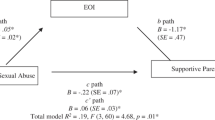Abstract
This study examined the relationship between parent and child reports of supportiveness of intrafamilially sexually abused children and levels of child psychopathology. Fifty-four intrafamilially sexually abused children completed a revised version of the Family Subscale of the Survey of Children's Social Support and the Child Assessment Schedule. Fifty-four parents completed a version of the Family Subscale of the Survey of Children's Social Support, modified for use in parental reporting of their own supportive behaviors. Satisfactory reliability levels were obtained for the revised measures. This study of 54 sexually abused children and their non-offending parents found that although most non-offending parents were supportive of their children, the children reported considerable distress. Although there was no significant difference in mean levels of support reported by parents and children, the two measures were not significantly correlated. This suggests that parents and children perceive supportive behavior differently, although both constructs are of importance. Multiple regression analysis found that both child and parent reports of parental support were predictive of levels of child psychopathology, but that child estimates were a stronger predictor.
Similar content being viewed by others
References
Alter-Reid, K., Gibbs, M.S., Lachenmeyer, J.R., Sigal, J. & Massoth, N.A. (1986). Sexual abuse of children: A review of the empirical findings. Clinical Psychology Review, 249–266.
Beitchman, J.H., Zucker, K.J., Hood, J.E., daCosta, G.A., Akman, D., & Cassavia, E. (1992). A review of the long-term effects of child sexual abuse. Child Abuse & Neglect, 101–118.
Briere, J.N. & Runtz, M. (1993). Child sexual abuse: Long-term sequelae and implications for psychological assessment. Journal of Interpersonal Violence, 8, 312–330.
Conte, J. (1982). Sexual abuse of children: Enduring issues for social work. In J.R. Conte & D. Shore (Eds.), Social Work and Child Sexual Abuse (pp. 1–19). New York: Haworth.
Courtois, C.A. (1980). Studying and counseling women with past incest. Victimology, 322–334.
deYoung, M. (1994). Immediate maternal reactions to the disclosure or discovery of incest. Journal of Family Violence, 9, 21–33.
DuBow, E.F. & Ullman, D.G. (1989). Assessing social support in elementary school children: The survey of children's social support. Journal of Clinical Child Psychology, 52–56.
Everson, M.D., Hunter, W.M., Runyon, D.K., Edelsohn, G.A. & Coulter, M.L. (1989). Maternal support following disclosure of incest. American Journal of Orthopsychiatry, 59, 197–207.
Finkelhor, D. (1984). Child Sexual Abuse: New Theory and Research. New York: Free Press.
German, D.N.E., Habenicht, D.J. & Futcher, W.G. (1990). Psychological profile of the female adolescent incest victim. Child Abuse & Neglect, 14, 429–438.
Gilgun, J.F. (20 November 1983). Toward an explanation of child sexual abuse using life course theory and theory-guided research. Paper presented at the Annual Meeting of the Society for the Scientific Study of Sex, Chicago, IL.
Hall, J., Griffin, H., Cronin, M. & Thompson, B. (1985). Factors related to competency test performance for high school learning disabled students. Educational Evaluation & Policy Analysis, 7, 151–160.
Hodges, K., Kline, J., Cytryn, L., & McKnew, D. (1982). The development of a child assessment schedule for research and clinical use. Journal of Abnormal Child Psychology, 173–189.
Hodges, K., McKnew, D., Cytryn, L., Stern, L., & Kline, J. (1982). The Child Assessment Schedule (CAS) diagnostic interview: A report on reliability and validity. Journal of American Academy of Child Psychiatry, 468–473.
Hodges, K., Cools, J., & McKnew, D. (1989). Test-retest reliability of a clinical instrument for children: The Child Assessment Schedule (CAS). Psychological Assessment: Journal of Consulting and Clinical Psychology, 317–322.
Hulme, P.A. & Grove, S.K. (1994). Symptoms of female survivors of child sexual abuse. Issues in Mental Health Nursing, 519–532.
Husain, A. & Chapel, J.L. (1983). History of incest in girls admitted to a psychiatric hospital. American Journal of Psychiatry, 140, 591–593.
Lawler, M.K., Volk, R.J., Viviani, N. & Mengel, M.B. (1990). Individual and family factors impacting diabetic control in the adolescent: A preliminary study. Maternal Child Nursing Journal, 19, 331–345.
Leifer, M., Shapiro, J.P. & Kassem, L. (1993). The impact of maternal history and behavior upon foster placement and adjustment in sexually abused girls. Child Abuse & Neglect, 17, 755–766.
Leifer, M., Shapiro, J.P., Kassem, L. & Lang, A.M. (25 March 1993). Longitudinal study of the psychological effects of sexual abuse in foster children and children who return home. Paper presented at the Biennial Meeting of the Society for Research in Child Development, New Orleans, LA.
Lindberg, F.H. & Distad, L.J. (1985). Post-traumatic stress disorders in women who experienced childhood incest. Child Abuse & Neglect, 329–334.
Machotka, P., Pittman, F., & Flomenhaft, S. (1967). Incest as a family affair. Family Process, 6(1), 98–116.
Myer, M.H. (1984). A new look at mothers of incest victims. Journal of Social Work and Human Sexuality, 3, 47–58.
Pierce, R. & L.H. Pierce (1985). The sexually abused child: A comparison of male and female victims. Child Abuse & Neglect, 9, 191–199.
Reis, S.D. & Heppner, P.P. (1993). Examination of coping resources and family adaptation in mothers and daughters of incestuous versus nonclinical families. Journal of Counseling Psychology, 40, 100–108.
Sirles, E.A. & Franke, P.J. (1989). Factors influencing mothers' reactions to intra-familial sexual abuse. Child Abuse & Neglect, 13, 131–139.
Thernlund, G.M. & Samuelsson, M.A. (1993). Parental social support and child behavior problems in different populations and socioeconomic groups: A methodological study. Social Science & Medicine, 36, 353–360.
U.S. Bureau of the Census (1996). Statistical Abstract of the United States. Washington, D.C.: Government Printing Office.
Watson, T., Brown, M. & Swick, K.J. (1983). The relationship of parents' support to children's school achievement. Child Welfare, 42, 175–180.
Author information
Authors and Affiliations
Rights and permissions
About this article
Cite this article
Avery, L., Massat, C.R. & Lundy, M. The Relationship Between Parent and Child Reports of Parental Supportiveness and Psychopathology of Sexually Abused Children . Child and Adolescent Social Work Journal 15, 187–205 (1998). https://doi.org/10.1023/A:1022236502166
Issue Date:
DOI: https://doi.org/10.1023/A:1022236502166




